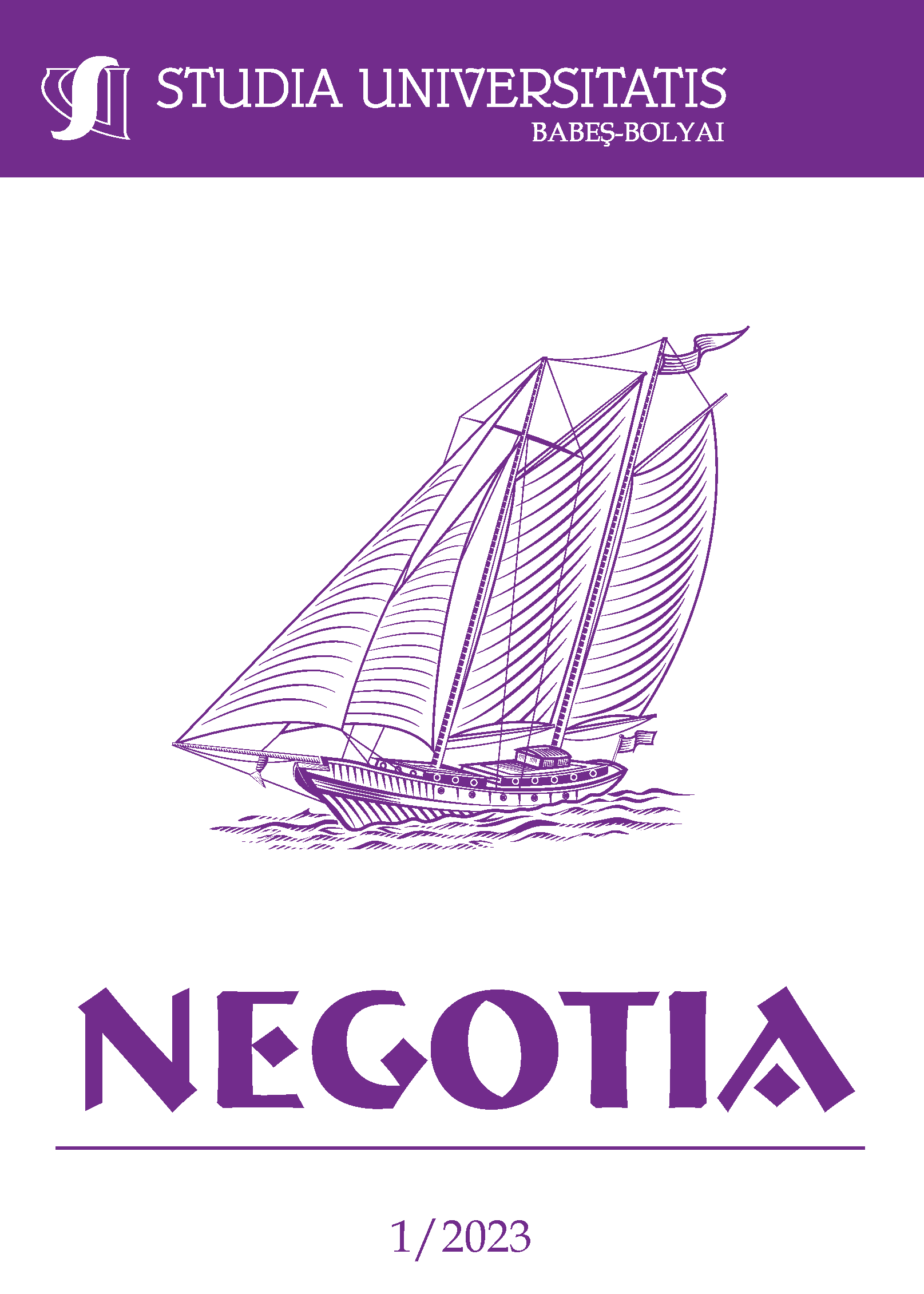ADAPTIVE FACEBOOK COMMUNICATION OF ORTHODOX ENTITIES IN COVID-19 CONTEXT
DOI:
https://doi.org/10.24193/subbnegotia.2023.1.02Keywords:
religious communication, adaptive communication, Facebook, Orthodox, COVID-19Abstract
A generalized migration of the consumers to digital channels was observed during the COVID-19 pandemic situation. In this context, the purpose of the research was to analyze the online options the consumer of religious services had and the way Church adapted its communication at the new circumstances. Questions regarding the intensity of communication, posts’ type or frequency, and reactions were investigated through a longitudinal retrospective study focused on Facebook platform. More than 6,150 posts and 1.6 million reactions were included. Distinctive profiles were observed: monasteries vs. urban parishes vs. rural ones. The study suggests that the pattern of consumers’ reactions was influenced by the type of the posts. The impact that online messages have, advocates for a professional approach or support in communication. The results may serve as informational input for a future unitary communication strategy of religious entities.
Article history: Received January 13, 2023; Reviewed January 31, 2023; Accepted February 10, 2023; Available online March 30, 2023; Available print April 30, 2023.
JEL Classification: M31, Z12, O33
References
Adams, J., Mladenović, K., Pendlebury, D., & Potter, R. (2022). Global Research Report. Central Europe: A profile of the region and its place in the European research network (p. 25). Institute for Scientific Information, https://s786780033.t.en25.com/e/bfs?s=786780033&lguid=6f27474b6d9d41bd89b8959038b043a0&elqTrackId=d436a162fcd340a29415dece86584f70&elq=991de48c5eb74b0ba3f79da34074f254&elqaid=19945&elqat=1&elqCampaignId=8454
ANCOM. (2021). 2020 Annual Report. Romanian National Authority for Administration and Regulation in Communications, https://www.ancom.ro/en/downloadFile/url/raport_anual_2020_EN.pdf.
Andok, M. (2021). Trends in Online Religious Processes during the Coronavirus Pandemic in Hungary—Digital Media Use and Generational Differences. Religions, 12(10), 808, https://doi.org/10.3390/rel12100808.
Campbell, H. (2005). Making Space for Religion in Internet Studies, The Information Society, 21(4), 309–315, https://doi.org/10.1080/01972240591007625.
Campbell, H. (2020). Digital Ecclesiology: A Global Conversation. Digital Ecclesiology: A Global Conversation, 71, https://doi.org/10.21423/DIGITALECCLESIOLOGY.
Cooper, A.P., Jormanainen, I., Shipepe, A., & Sutinen, E. (2021). Faith communities online: Christian churches’ reactions to the COVID-19 outbreak. International Journal of Web-Based Communities, 17(2), 99, https://doi.org/10.1504/IJWBC.2021.114453.
His Beatitude Daniel. (2015, mai). Message of Archbishop of Bucharest and Patriarch of the Romanian Orthodox Church, Daniel. 1st International Conference on Digital Media and Orthodox Pastoral Care, http://www.dmopc15.com/addresses-by-primates-of-churches/#sp_4480.
Hodøl, H.O. (2021). What a Friend We Have in Facebook: Norwegian Christian Churches’ Use of Social Media. Journal of Media and Religion, 20(3), 123–142, https://doi.org/10.1080/15348423.2021.1954829.
Hood, R.W., Hill, P.C., & Spilka, B. (2009). The psychology of religion: An empirical approach (4th ed). Guilford Press.
Hoover, S.M., Clark, L.S., & Rainie, L. (2004). Faith Online. PEW Internet & American Life Project, https://www.pewtrusts.org/en/research-and-analysis/reports/2004/04/07/faith-online.
Hutchings, T. (2011). Contemporary religious community and the online church. Information, Communication & Society, 14(8), 1118–1135, https://doi.org/10.1080/1369118X.2011.591410.
Isetti, G., Stawinoga, E. A., & Pechlaner, H. (2021). Pastoral Care at the Time of Lockdown: An Exploratory Study of the Catholic Church in South Tyrol (Italy). Journal of Religion, Media and Digital Culture, 10(3), 355–381, https://doi.org/10.1163/21659214-bja10054.
KPMG. (2020). COVID-19 pulse survey November 2020, Responding to consumer trends in the new reality. KPMG, https://home.kpmg/xx/en/home/insights/2020/06/consumers-and-the-new-reality.html.
Lim, A. (2017). Effective Ways of Using Social Media: An Investigation of Christian Churches in South Australia. Christian Education Journal: Research on Educational Ministry, 14(1), 23–41, https://doi.org/10.1177/073989131701400103.
Lövheim, M. (2008). Rethinking Cyberreligion?: Teens, Religion and the Internet in Sweden. Nordicom Review, 29(2), 205–217, https://doi.org/10.1515/nor-2017-0186.
Luke of Crimea, & Chiriac, D. (2018), Stiinta si religia. Doxologia.
Margherita, A., & Heikkilä, M. (2021). Business continuity in the COVID-19 emergency: A framework of actions undertaken by world-leading companies. Business Horizons, 64(5), 683–695, https://doi.org/10.1016/j.bushor.2021.02.020.
Mathew, G.C., Prashar, S., Ramanathan, H.N., Pandey, U.K., & Parsad, C. (2019). Impact of religiosity, spirituality, job satisfaction and commitment on employee performance: A quantile regression approach. International Journal of Indian Culture and Business Management, 19(4), 491, https://doi.org/10.1504/IJICBM.2019.104797.
Nyland, R., & Near, C. (2007, februarie). Jesus is my friend: Religiosity as a mediating factor in Internet social networking use. AEJMC Midwinter Conference, Reno, NV, https://scholar.google.com/scholar?i=bibs&cluster=3803803653465801501&btnI=1&hl=en.
Osei-Tutu, A., Affram, A.A., Mensah-Sarbah, C., Dzokoto, V.A., & Adams, G. (2021). The Impact of COVID-19 and Religious Restrictions on the Well-Being of Ghanaian Christians: The Perspectives of Religious Leaders. Journal of Religion and Health, 60(4), 2232–2249, https://doi.org/10.1007/s10943-021-01285-8.
Paloutzian, R. F., & Park, C. L. (Ed.). (2005). Handbook of the psychology of religion and spirituality. Guilford Press.
Radde-Antweiler, K., & Grünenthal, H. (2020). ‘New Possibilities for Carrying out their Ministry to and for the Word of God’? The Roman Catholic Church as a Religious Organisation in Times of Deep Mediatisation. Ecclesial Practices, 7(1), 67–82, https://doi.org/10.1163/22144417-bja10005.
Smith, G. A. (2021, decembrie 14). About Three-in-Ten U.S. Adults Are Now Religiously Unaffiliated. PEW Research Center, https://www.pewforum.org/2021/12/14/about-three-in-ten-u-s-adults-are-now-religiously-unaffiliated/.
Staniloae, D. (1996). Teologia dogmatica ortodoxa (Vol. 3). Editura Institutului Biblic si de Misiune al Bisericii Ortodoxe Române.
Statista. (2021, iunie 1). Most important social media and messaging platforms used in Romania, https://www.statista.com/statistics/1104242/social-media-platforms-romania/.
Todoran, I., & Zagrean, I. (2009). Teologia dogmatica: Manual pentru seminariile teologice. Renasterea.
Verschoor-Kirss, A., & College, W. (2012). Even Satan Gets Likes on Facebook. The Dynamic Interplay of Religion and Technology in Online Social Networks. Journal of Religion & Society, 14.
Volkova, Y. A. (2021). Transformations of Eastern Orthodox Religious Discourse in Digital Society. Religions, 12(2), 143, https://doi.org/10.3390/rel12020143.
Wong, A., Ho, S., Olusanya, O., Antonini, M.V., & Lyness, D. (2021). The use of social media and online communications in times of pandemic COVID-19. Journal of the Intensive Care Society, 22(3), 255–260, https://doi.org/10.1177/1751143720966280.
World Health Organization. (2020, martie 11). WHO Director-General’s opening remarks at the media briefing on COVID-19—11 March 2020. World Health Organization, https://www.who.int/director-general/speeches/detail/who-director-general-s-opening-remarks-at-the-media-briefing-on-covid-19---11-march-2020.
Downloads
Published
How to Cite
Issue
Section
License
Copyright (c) 2023 Studia Universitatis Babeș-Bolyai Negotia

This work is licensed under a Creative Commons Attribution-NonCommercial-NoDerivatives 4.0 International License.



